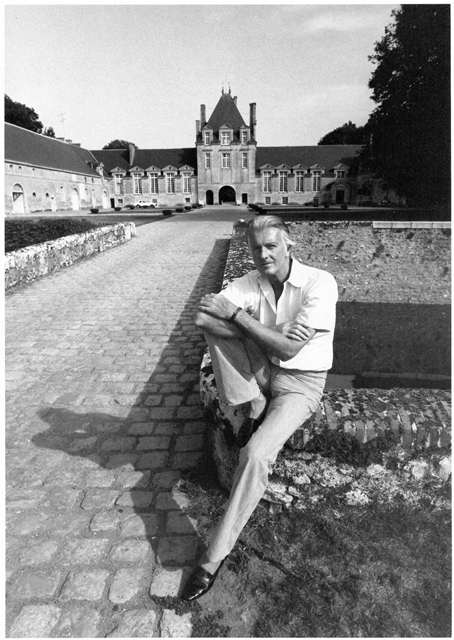Hubert de Givenchy
Born: Beauvais, France, 1927
Died: Neuilly-sur-Seine, France, 2018

Copyright © AFP / Jean-Régis Roustan / Roger Viollet
Hubert de Givenchy’s father died at a young age leaving Givenchy and his brother to be raised by his mother and grandmother. At the age of ten Givenchy visited the World’s Fair in Paris in 1937. The trip started Givenchy’s interest in fashion. After studying at the College Felix Faure in Beauvais Givenchy left for Paris to study at the Ecole Nationale Superieure des Beaux Arts to follow his passion for fashion.
Through family associations, Givenchy was able to secure work at Jacques Fath in 1945. This led to him working for Robert Piguet and Lucien Lelong from the recommendation of Christian Dior. The experiences led to him working for avant-garde designer Elsa Schiaparelli for four years until 1951. Givenchy opened his own house in February 1952. Foreseeing the relaxation and democracy of fashion, Givenchy launched separates including blouses and skirts made from raw cotton. At the age of 25, Vogue described him as ‘One of the most newsworthy happenings this spring.’
Two years later, Givenchy became the first major fashion designer to present a luxury R-T-W collection. At the time he was one of the youngest designers on the Paris fashion scene and, in 1953, his designs were featured on the cover of Life.
In 1953 Givenchy expected to meet Katharine Hepburn for a fitting. However, Audrey Hepburn arrived instead. The meeting resulted in a life long friendship between the two. The ongoing relationship saw Givenchy design almost all of her wardrobes in later movies including Sabrina, Funny Face and Breakfast at Tiffany’s .
As Hepburn’s fame grew, so did Givenchy’s, together entering the circle of the world’s best dressed women. Together the designer and his muse created a new kind of beauty, which helped develop thesixties inspired style.
In 1957 Givenchy launched his perfume, L’Interdit. Givenchy used Hepburn to promote the fragrance, marking the first time an actress allowed her face to be used for a perfume. The partnership was an enormous success with Americans adoring the duo.
Givenchy launched his men’s fashion line in 1973. “Gentleman Givenchy” saw his supreme creation.
Givenchy kept close relationships with his clients often crossing the line between couturier and friendship. Notably, in 1972, Givenchy dressed his friend the Duchess of Windsor in a black dress and coat for her husband’s funeral, which he made in less than 48 hours.
Having previously delayed launching licensing agreements upon the advice of his mentor Cristóbal Balenciaga, Givenchy finally did so in the seventies to ensure the continuation of his haute couture collections. This followed with the fashion house’s expansion moving into home collections, jewellery, shoes and even a car in 1976, the Ford Lincoln Continental.
In 1988 Givenchy joined LVMH. Three years later Givenchy celebrated forty years in fashion. Holding an exhibition at the Palais Galliera in Paris, Hepburn inaugurated the proceedings.
Givenchy retired in 1995 and was succeeded by a list of young British designers. John Galliano was appointed in January 1996 followed by Alexander McQueen in October 1996. Julien MacDonald followed in 2001, with Ozwald Boateng appointed from 2003 – 2005. In 2005 Riccardo Tisci was finally appointed Creative Director and has remained there since.
Known as the perfect gentleman of couture, Hubert de Givenchy created elegant, pure, sculptural styles that featured feminine qualities. Impeccably turned out, Givenchy was a true master of style.
In 2005, Riccardo Tisci took over as the artistic director of womenswear at Givenchy, bringing his unique style and influences to the brand. He infused a dark and sensual romanticism, making notable changes to the house codes.
Currently, Philippe Fortunato, formerly the Chief Operating Officer of LVMH Moet Hennessy Vuitton SA – China, serves as the Chief Operating Officer at Givenchy.Givenchy designs have been embraced by numerous celebrities for red carpet events, with notable appearances by Rooney Mara at the 2012 Academy Awards and Madonna’s costumes for her Sticky & Sweet tour and the 2012 Super Bowl Halftime Show.
In 2016, Riccardo Tisci collaborated with Nike on a sportswear collection called NikeLab x RT: Training Redefined, targeting both Olympic athletes and everyday gym-goers during the 2016 Summer Olympics. After working as Creative Director for twelve years, Riccardo Tisci announced his departure from Givenchy in February 2017.
Clare Waight Keller succeeded Tisci and became the artistic director of Givenchy from May 2, 2017. She took charge of all creative aspects, overseeing Women’s and Men’s Ready-to-wear, accessories collections, and Haute Couture. One of her notable achievements was designing the gown worn by Meghan Markle at her wedding to Prince Harry in May 2018. Under Clare Waight Keller’s guidance, the brand reintroduced the menswear collection for the autumn/winter 2019 season after successfully running several combined shows.
In June 2020, Matthew Williams, renowned for co-founding the influential streetwear brand 1017 ALYX 9SM, joined Givenchy as the new creative director. Williams’ edgier aesthetic has been embraced by celebrities such as Kendall Jenner and Bella Hadid, though his work has received mixed reviews, with some questioning the brand’s distinct identity under his direction.
Hubert de Givenchy Biography
